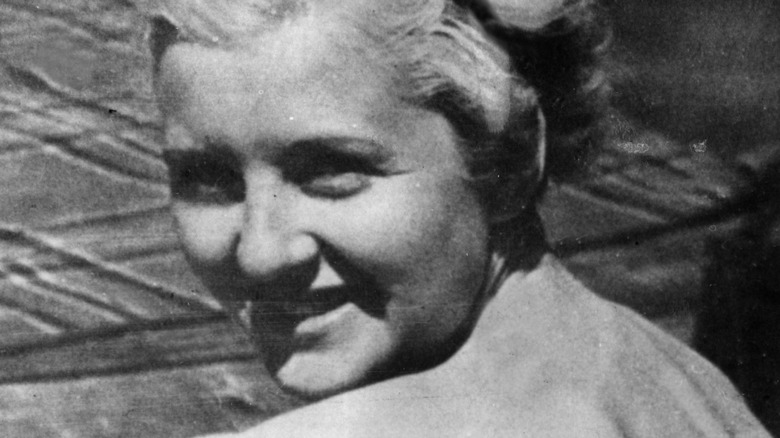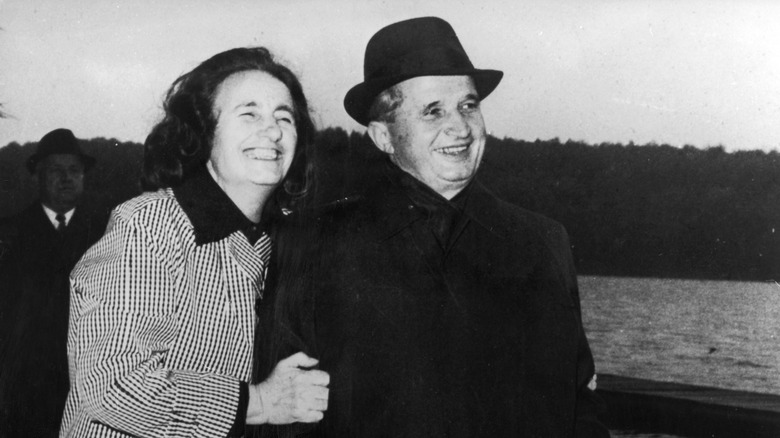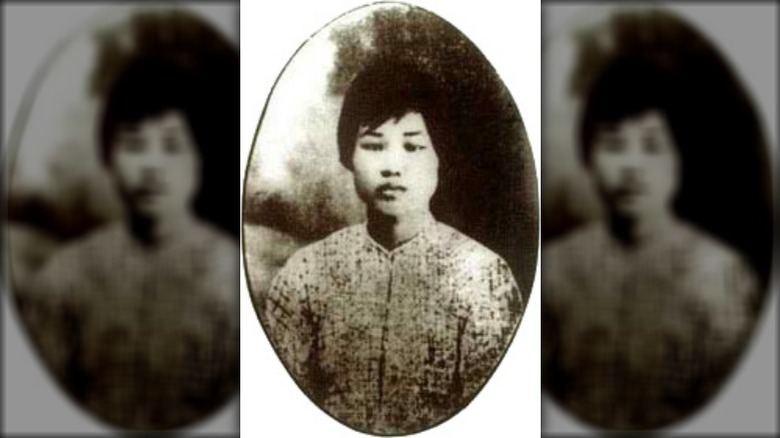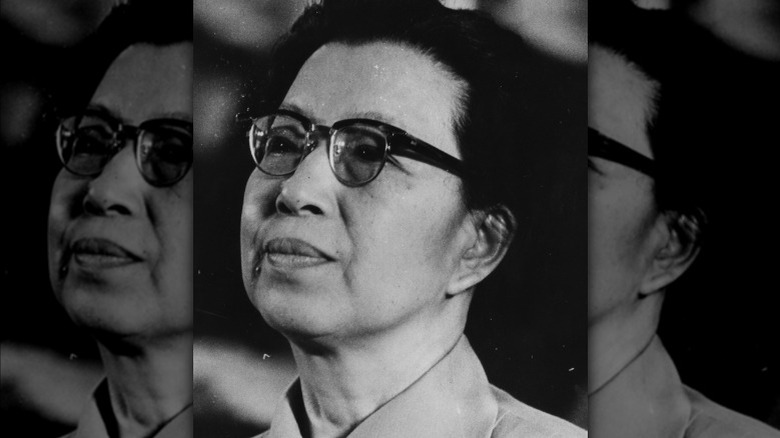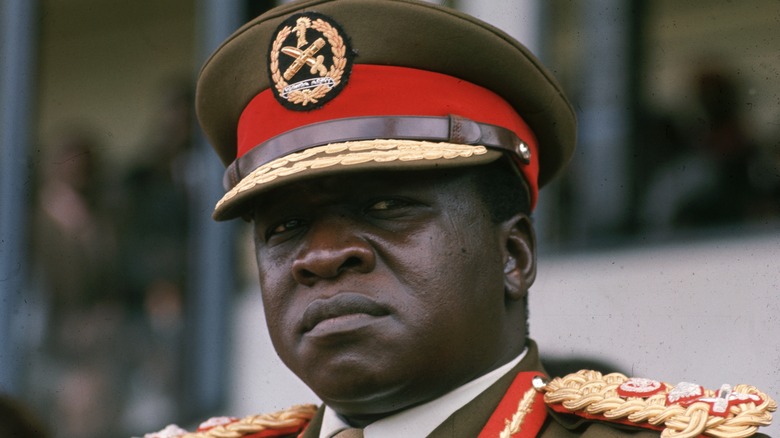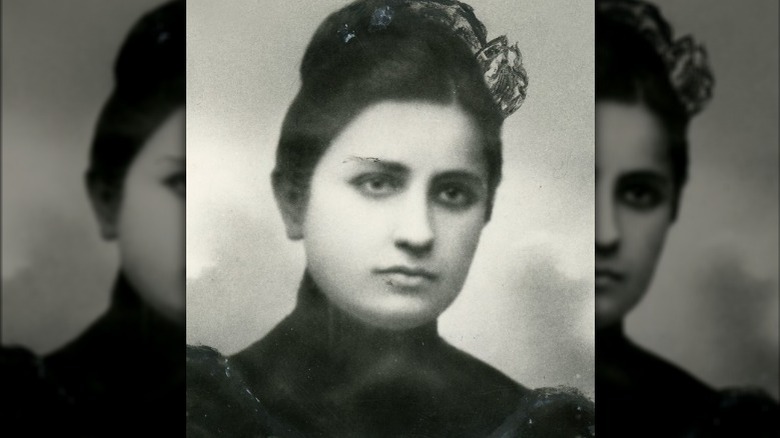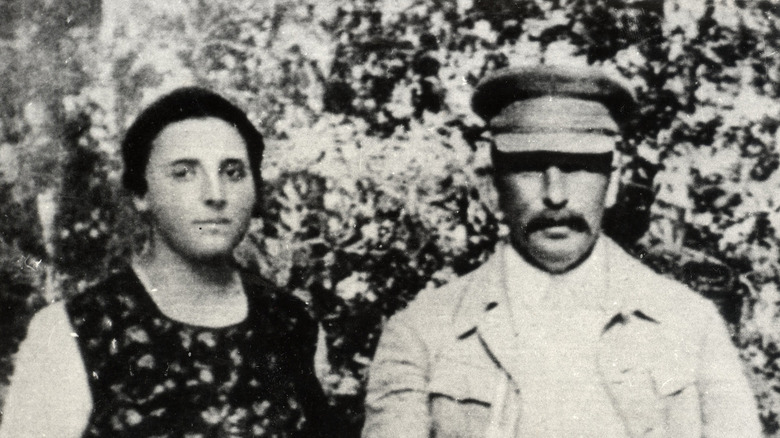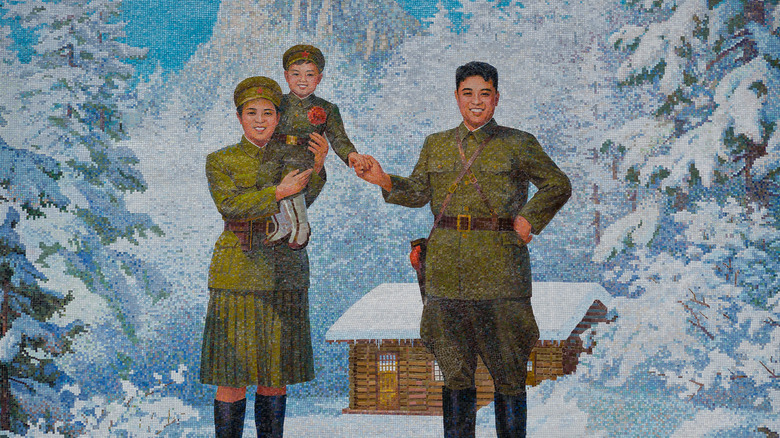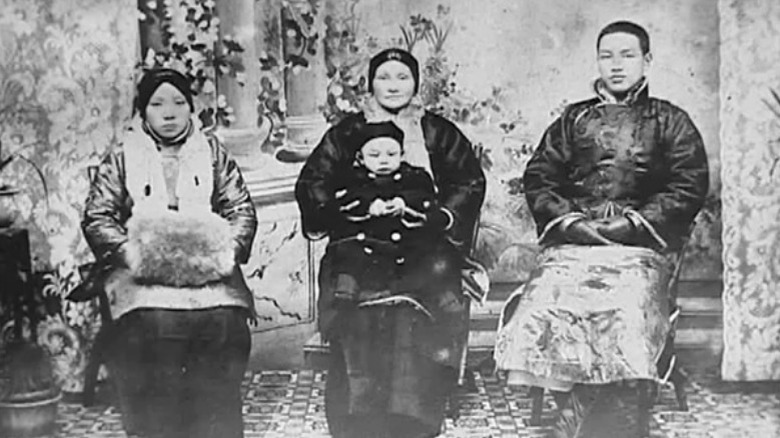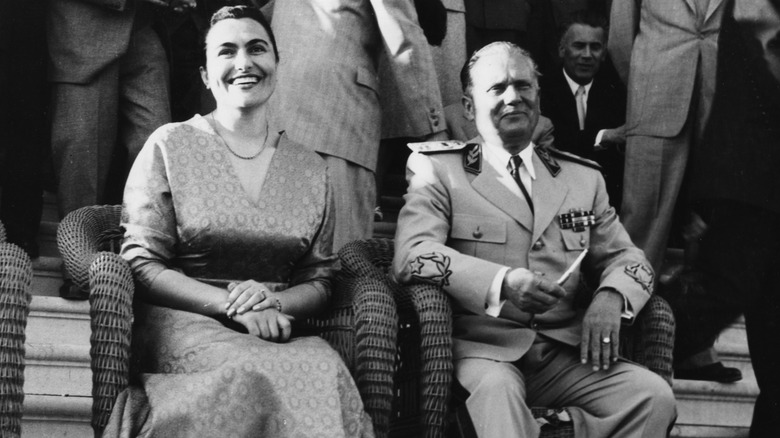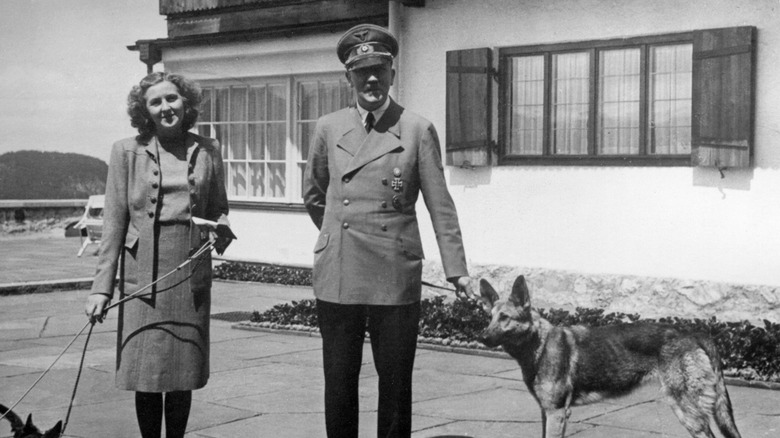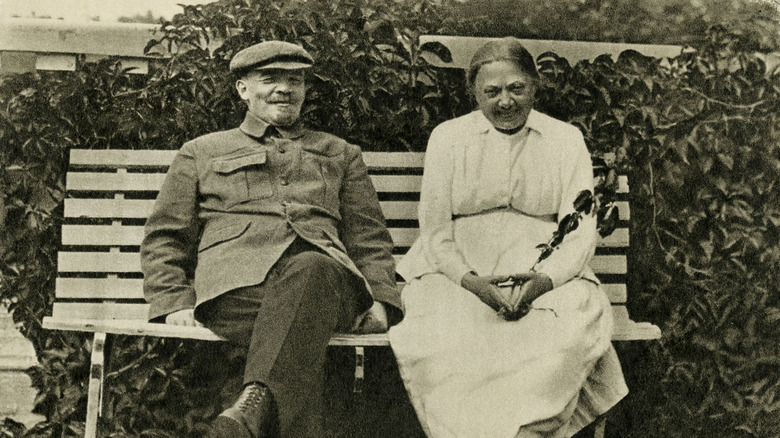Dictators' Wives Who Died Awful Deaths
There is no particularly nice way to die. However, if one was forced to come up with the least-bad way, most people would probably say something like dying at home in bed, surrounded by loved ones, slipping away with little pain. Unfortunately, for many people, that's not going to be even close to reality. However, as long as you don't die the way the wives of these dictators did, you won't have too much to complain about.
Not all these women married by choice, and some of them got hitched well before their husbands became dictators. They were just regular women who found themselves in arranged marriages or in love with the boy next door, with no idea of what he would become. Others, however, went into their relationships with dictators with their eyes wide open. Some were just as ruthless as their husbands, playing a key role in the subjugation of their citizens.
As with many of their husbands, some of these women died in violent circumstances, while others died from relatively natural, if terrible, causes. Here are dictators' wives who died awful deaths.
Elena Ceauşescu
In 1989, as the Iron Curtain started to fall across Eastern Europe, the reign of Romania's dictator Nicolae Ceauşescu came to a sudden and dramatic end. The inflection point occurred during a speech that did not get the normal cheers from the subjugated crowd but booing. "I was there when the people turned," one witness to the event told The Independent years later. "It was exhilarating because this man had ruled every aspect of our lives since before we could remember. And none of it had been good whatever lies he had spun."
By Christmas Day, a show trial resulted in a death sentence for both Nicolae and his wife Elena. The execution took place immediately and since much of it was recorded, we know how Elena reacted to her imminent death, alternating from pleading to cursing those involved. One of the men in the firing squad, Ionel Boyeru, told the British tabloid The Mirror, "She yelled at a soldier, 'You motherf****er." Other sources reported that she said, "Why, why? I raised you like a mother." Contemporary reports in the Los Angeles Times and the AP recorded that she tried to flee and openly wept, respectively.
Boyeru told The Guardian the pair were executed together as a kindness, since they were "still very much in love" and, "I shot them very fast. I feel I helped them to die with dignity."
Yang Kaihui
According to the "Biographical Dictionary of the People's Republic of China," future Chinese dictator Mao Zedong had an arranged marriage as a young teenager with a girl named Luo Yixiu. The marriage was not a success, and Luo died less than two years later from illness. Later in life, Mao refused to even recognize the existence of the marriage.
Mao chose his second wife, Yang Kaihui, in 1920. In "The Private Life of Chairman Mao," Mao's personal doctor Li Zhisui concludes that the dictator did not register the suffering of other humans. That might be the reason he callously rejected Yang as well, although her death was very different than that of the woman who preceded her.
Yang left writings showing she was clearly aware that Mao was constantly cheating on her. While she eventually lost faith in his politics, she still loved him, per "Mao: The Unknown Story." Mao, however, didn't seem to return that affection. He was off fighting when he met another revolutionary, He Zizhen. The couple married in 1928, without waiting for Mao to legally divorce Yang.
Despite this rejection and abandonment, Yang stood by her husband to the very end. In 1930, she was captured by the Kuomintang, the nationalist Chinese government her communist husband was still trying to overthrow. She chose death over betraying Mao to his enemies, and was executed after being tortured.
Jiang Qing
Mao Zedong's final marriage was to Jiang Qing, who would go on to become almost as infamous as her husband. He married her in 1939 after divorcing his third wife, He Zizhen, which was not a popular move in China. When Jiang started throwing her political muscle around in the 1960s, she proved to be ruthless, helping mastermind the Cultural Revolution.
Mao died in 1976, and within a year, Jiang had fallen from her lofty heights. In 1980, she was put on trial for crimes committed during the Cultural Revolution and sentenced to death the next year. Her defense, as quoted in The Washington Post, was that she did what Mao ordered her to do, or, as she famously put it, "I was Chairman Mao's dog. Whomever he told me to bite, I bit." The execution was delayed for two years and in 1983, The Washington Post reported her sentence had been commuted to life in prison, as she had reformed.
Only four years later, Jiang was diagnosed with throat cancer. Before cancer could kill her, she died by suicide in 1991. China rejoiced at her death, with Shanghai's Liberation Daily stating, "it goes without saying that death cannot expiate her crimes" (via The Los Angeles Times).
If you or anyone you know is having suicidal thoughts, please call the National Suicide Prevention Lifeline by dialing 988 or by calling 1-800-273-TALK (8255).
Kay Amin
In the 1975-76 issue of Transition, African political journalist Colin Legum wrote about the then-alive and still powerful dictator Idi Amin. But his wives got their own section, and for good reason. As Legum poetically phrased it, "The story of Amin will furnish some future Ugandan Shakespeare with more than enough material for ... an African 'Henry VIII.'"
Idi Amin married numerous times and practiced polygamy. Kay Adroa wed the already-married Idi in 1966, five years before he took power in Uganda. By 1973, Idi's relationship with Kay had deteriorated completely. After he had a politician who had fallen from favor killed, Kay left him. In retaliation, Idi announced he was divorcing her, as well as two other wives. Two months later, Kay was arrested on trumped-up charges. She was released, but much worse was soon to come.
In August 1974, UPI reported (via The New York Times) that Kay Amin's dismembered body had been discovered in the trunk of her doctor's car. The same doctor had died –- allegedly by suicide –- the day before her body was found. The official story was that she died after a botched abortion, the doctor tried to hide the body, then killed himself when he failed to do so, although there is little evidence of what actually happened.
Kato Svanidze
Joseph Stalin married his first wife long before he became the dictator feared by millions. In the early 1900s, Stalin, then going by his birth name Ioseb Jughashvili, was already involved in revolutionary politics. At one point, he used a safe house owned by the Svanidze family in present-day Tbilisi, Georgia, according to "Stalin: Paradoxes of Power, 1878-1928." One of the family's three daughters evidently caught Stalin's eye, and while he spent much of his time at the house working on political projects, he also got Kato Svanidze pregnant. In 1906, the pair decided to get married.
While friends remembered Stalin as being very much in love with his wife, he also immediately abandoned her for the cause. During her pregnancy, Svanidze spent six weeks in jail for the crime of marrying Stalin. When she gave birth, he was away. Finally, when facing charges of robbery in Tbilisi, Stalin moved his wife and son far from her family.
Their new home, Baku, was not a good environment for Svanidze and she only stayed about five months, then returned to her family. Once she was back home, she became deathly ill. While her exact cause of death is not certain, it was certainly not dignified or painless, since she was "hemorrhaging blood from her bowels." While Stalin was distraught at her death, he took off again, abandoning his son for over a decade.
Nadezhda Alliluyeva
After the death of Stalin's first wife in 1907, the dictator didn't marry again until 1918, a year after the Russian Revolution, according to "Stalin: An Unknown Portrait." So when Nadezhda Alliluyeva wed the man 23 years her senior, she knew who he was, or at least what he might become.
Stalin was horrible to his second wife. He alternated between raging at her and ignoring her. Nadya fought back when she could, but by 1932, witnesses said she was completely beaten down by her tyrannical husband and crushed by his many extramarital affairs. After another fight, she said a final goodbye to her young children, then told the servants she wasn't to be disturbed. She was found dead the next morning, reportedly by suicide.
For decades, her cause of death was covered up by the USSR, attributed to either appendicitis or heart problems. The silence was broken in 1988 when Russian playwright Mikhail Shatrov was interviewed by a USSR publication. When asked about Stalin, Shatrov said, "His relations toward women? I know little about this question. We know about the suicide of his wife. In any case, Stalin was always crude." As The New York Times reported, this casual reply was the first known time someone in the communist country publicly admitted how Stalin's second wife died.
If you or someone you know is dealing with domestic abuse, you can call the National Domestic Violence Hotline at 1−800−799−7233. You can also find more information, resources, and support at their website.
If you or anyone you know is having suicidal thoughts, please call the National Suicide Prevention Lifeline by dialing 988 or by calling 1-800-273-TALK (8255).
Kim Jong-suk
When it comes to the ruling family of North Korea, being ordinary, or even run-of-the-mill extraordinary, isn't good enough. On the 100th birthday of Kim Jong-suk — wife of North Korea's first president Kim Il-sung and grandmother of current tyrant Kim Jong-un — politician Yang Hyong-sop gave a speech touting her greatness. "The human history recorded a large number of famous women revolutionaries but has not known such a prominent woman revolutionary and genuine patriot as Kim Jong-suk," he said (via North Korea Leadership Watch).
Of course, when it comes to women in a hereditary dictatorship, there's only one thing that really counts: giving birth to a son. As Yang put it, "she brought up leader Kim Jong-il as the rising sun and thus gave the people the highest honor and happiness of being blessed with the illustrious leaders generation after generation."
Sadly, it was another pregnancy that would end her life at just 31 years old. Her exact cause of death is uncertain. Some report it was due to an ectopic pregnancy (per "Kim Jong-il: North Korea's Dear Leader"), while others say she died from complications delivering a stillborn baby (via "Kim Il Sung: The North Korean Leader"). Official North Korean reports, on the other hand, say she died because she had put all her strength into fighting for the country. Kim Jong-suk died in 1949, one year after the founding of North Korea, when her son, future dictator Kim Jong-il, was 7.
Mao Fumei
Mao Fumei (pictured left) was the first wife of Chiang Kai-shek, the former dictator of China and Taiwan. The marriage, arranged when both were teenagers, was disastrous from the start. Mao moved into the Chiang family home and watched as the dynamics of the household destroyed what little chance her marriage ever had. She later remembered, "I kept quiet and seldom spoke ... The situation went from bad to worse, and Kai-shek soon became impatient with me. I dared not say one word to defend myself ... All I could do was to weep secretly over my utter helplessness" (via "Chiang Kai Shek: China's Generalissimo and the Nation He Lost").
The marriage had been arranged by Chiang's mother, so it was only after she died that Chiang divorced Mao. "For the past 10 years, I have not been able to bear the sound of her footsteps or seeing her shadow," he wrote of his spouse of two decades, according to "The Generalissimo: Chiang Kai-shek and the Struggle for Modern China."
After the divorce, Mao continued to live in the Chiang family home. In 1939, during The Second Sino-Japanese War, Japan's military tried to punish Chiang by bombing his hometown. While Mao fled at the air raid warning, a bomb landed right next to her, killing her instantly. Later, her son with Chiang would lay a stone reading "It takes blood to wash out blood" in the location (via "The Generalissimo's Son: Chiang Ching-Kuo and the Revolutions in China and Taiwan").
Lucia Bauer
Yugoslavian dictator Josip Tito married several times and didn't remember all his marriages fondly. (Tito is pictured above with his fourth wife, Jovanka Budisavljević.) When it comes to Tito's relationship with his first wife, Pelagija Belousova, "It seemed as if he wanted to blot out every trace of it from his life and his memory," said fellow politician Milovan Djilas (via "Tito" by Neil Barnett).
Tito made a solid effort at that goal with his second marriage. In 1936, while still married to Belousova, the not-yet dictator met Johanna König (aka Lucia Bauer) and quickly divorced Belousova to marry Bauer.
The marriage was a short one. In 1938, according to the North Macedonian newspaper Sloboden Pečat, Bauer was arrested and sentenced to death after a sham trial. Shortly after her execution, Tito wrote that he "felt guilty for not noticing his wife's treacherous actions due to lack of vigilance," despite likely being the one to denounce her.
Bauer is not included on many lists of Tito's wives, and Barnett writes that this was a deliberate cover-up. Tito was so secretive about his life, even his birthdate is up for debate. Shortly before Tito died, he declared to his personal physician, "If you think you know me and know who is Tito, you are hugely wrong, doctor ... you do not know who is Tito, nor will you ever know. No one met Tito, nor will meet him" (via EUobserver).
Eva Braun
Eva Braun met Adolph Hitler in 1929 when she was 17 years old and he was more than two decades older. While many people know the name of the woman who chose to be with one of the most infamous men in history, their idea of who she was is likely wrong, said Heike Görtemaker, author of the definitive biography on Braun (via The Guardian).
"Eva Braun features in films, plays, novels, and historical memoirs but is always portrayed as the dumb blonde who had the misfortune to fall in love with a devil, and this is an image that needs to be corrected," she said. "She was capricious, an uncompromising advocate of unconditional loyalty towards the dictator who went so far as to die with him, and he adored her."
In the Führerbunker in Berlin, towards the end of WWII, Braun was upbeat and threw semi-secret parties, Görtemaker recorded in "Eva Braun: Life With Hitler." Still only 33, she was staying with Hitler to the end, and they both knew it. In all the time they'd been together, he hadn't agreed to marry her, and in fact, kept their relationship relatively secret. But as things came to a head outside, the two married in the bunker in a small and informal ceremony.
Just a day and a half later, on April 30, 1945, the now-husband and wife sat alone in a room in the bunker, before they both died by suicide.
Nadezhda Krupskaya
In many ways, it's astonishing that Nadezhda Krupskaya lived as long as she did. The wife of Vladimir Lenin, she was a key player in the young Soviet Union. However, once Lenin died in 1924, some of her opinions (which she shared openly) put her at odds with Joseph Stalin. As "Toxic Politics" explains, Stalin had disposing of his enemies down to a science. So it should have been simple to take out this interfering widow and revolutionary figure. Yet, 15 years after her husband's death, Krupskaya was still alive and kicking ... and talking.
In the end, her death warrant may have been sealed by a rumor she was going to openly denounce Stalin on her 70th birthday in 1939, according to a paper in the Journal of Education for Library and Information Science. Two days before her birthday, she got together with about a dozen friends for a quiet but fancy dinner. Within hours of eating it, she passed out, and despite being quickly put under the care of multiple doctors, they all refused to treat her, for pretty flimsy reasons. Their decisions not to act were approved by Stalin, as "Toxic Politics" records.
Krupskaya died the day after her birthday. While the cause of death was blamed on everything from appendicitis to food poisoning to a blocked intestine, most sources give credence to the most logical explanation: Stalin had her poisoned.
